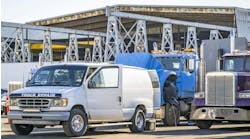Safety, fuel efficiency, operating performance and driver comfort all have to be factored in when determining the proper spec for your vehicles.
Being as fuel efficient as possible is a major consideration so investments in aerodynamics usually pay off. But make sure aero devices make sense for a given application because they are not right in every situation.
The engine-transmission-rear axle selection also play a role is fuel efficiency so those components need to be spec’d to align with specific duty cycles so they will function optimally together.
Automated transmissions serve a dual purpose. They usually provide better fuel economy — especially with inexperienced drivers — and they are less fatiguing to drive making them a good driver comfort spec.
Other driver comfort specs include upgraded cab interiors, Bluetooth/Sirius capable radios, as well as upgraded mattresses, refrigerators and APUs in sleepers. Also consider adding safety features like collision avoidance systems, lane departure warning systems, anti-rollover technology and smart cameras.
Given the current shortage, anything you can do to make the truck safer and more comfortable for your drivers can help attract and retain your driver workforce.
While it can be difficult to justify an investment in some of these technologies, it is likely that as time progresses many of these safety, fuel efficiency and driver comfort options will become standard on trucks and eventually everyone in the market will be looking for trucks with these key features. Consequently, trucks with these types of amenities and features will see increased value on the resale market so your investment is likely to be recouped that way.
When spec’ing safety-related features, another benefit could be deeper discounts from your insurance carrier. Enhanced safety features are designed to help reduce accidents and fewer accidents can result in a better insurance rating for your fleet and lower insurance premiums.
One point to remember when adding new technology to your trucks is to take time to train drivers on the proper operation so they understand how everything works so you can achieve the gains those components promise.



